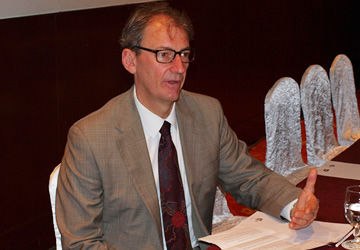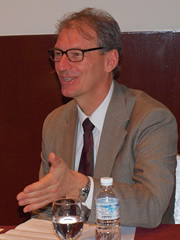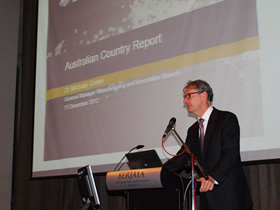Interview with Dr. Michael Green, General Manager, Space Policy Unit, Department of Industry, Innovation, Science, Research and Tertiary Education of Australia, at APRSAF-19 in Kuala Lumpur (Dec 2012)
<Part 1>
The APRSAF Secretariat interviewed Dr. Michael Green (General Manager, Space Policy Unit, Department of Industry, Innovation, Science, Research and Tertiary Education of Australia) at APRSAF-19 in Kuala Lumpur, Malaysia, in December 2012. He talked about the progress of Climate R3 (Regional Readiness Review for Key Climate Missions), one of the APRSAF initiatives, proposed by Australia at APRSAF-17 in Melbourne, December 2011.
Secretariat: Could you give us a brief introduction of the Climate R3 initiative?

The Climate R3 initiative (CR3) is the key climate initiative that we began at APRSAF-17. The key theme of the Melbourne meeting was "the role of space technology and industry in addressing climate change." We wanted to have an Australian-proposed initiative that would address climate change issues, giving them higher profile and greater prominence, and CR3 grew out of that idea. Following a successful workshop in Sydney in 2011, APRSAF-18 in Singapore endorsed CR3 as an ongoing and high-profile APRSAF activity managed under the EO WG.
We held a second meeting in Perth in May 2012 in conjunction with the SAFE workshop, with over 40 participants from 13 countries. At this meeting, we reinforced the role of CR3 in bringing together the users of climate data with the data suppliers to help increase understanding of each group's needs and what data are available. Building these connections is a key role for APRSAF and CR3 to address climate information needs.
S: What is the current phase or status of the CR3?

First, we are trying to identify and understand the climate information needs of countries in the region through APRSAF. Second, we are trying to build awareness of proposed upcoming climate-related missions as well as global initiatives. These include identifying key user requirements, identifying and promoting the information streams available, and helping build connections and relationships. This is the key focus we have for CR3.
What has been proposed at this APRSAF-19 is the conduct of a formal study of the data requirements for the Asia-Pacific region. This builds on work done in Australia over the last couple of years where we have systematically analyzed the needs that we have for earth observation data in Australia to identify where the information gaps are, what the future missions are, and what their probability of going ahead and meeting those needs are. Through this process, we aim to identify where we need to spend effort to ensure the continuity of data to meet the needs. Now we think there is merit in extending this approach, through APRSAF, to the Asia-Pacific region. So we can really understand and identify the needs for climate data, or climate-related data, and the key missions that can provide this data, highlighting any risks or vulnerabilities that we need to address.
S: So are you preparing to use the satellite data and data from other sources?
For example, Australia has a leading role in the Global Forest Observation Initiative (GFOI)*. We are working with Indonesia and other countries to help build forest-monitoring systems to undertake carbon accounting and reporting that are essential to a global response to climate change. Part of this is identifying practical ways to build a national forest-monitoring initiative that will meet the requirements of the global community in respect of monitoring, verification, and reporting. So this is the kind of work that can practically be done with other countries and is happening globally.
* GFOI: One of the initiatives of Group on Earth Observations (GEO)
S: So, in that sense, you have a common task or mission with SAFE.

Dr. Green giving a country report on Australia
at the plenary session
We certainly say that we have a strong connection with the SAFE agenda. We held a workshop in conjunction with the SAFE workshop in Perth, so I think that is clear. In CR3, we are looking to systematically help identify the needs of national carbon accounting and reporting mechanisms, so, obviously, there are initiatives around particular challenges in forest management or agriculture that present commonalities with SAFE. But there are additional challenges placed on nations in creating and maintaining systematic carbon accounting and reporting regimes that satisfy benchmarks. This is one thing that Australia is looking to help develop through CR3 involvement with initiatives such as the GFOI and the GEO Global Agricultural Monitoring initiative (GEO GLAM).
CR3 also involves other activities and organizations, such as the APEC climate center, and part of the workshop involved working with them to understand their information needs, how satellite data is contributing to those needs, where the gaps are, and where the vulnerabilities are. Again, highlighting this issue that we are building systems that presume the availability and continuity of satellite data and yet there are vulnerabilities in those data streams that are not well understood. There are also new data streams that are not well understood by the other climate communities. So CR3 is sort of a community of interest building attention in policy and other circles on the climate challenge. There are many space agencies and other agencies developing data, but I think there is a weakness in the connections being made. We see CR3 as a way of helping to build those connections or collaborations to better link the people who have data needs with the people who have data to provide, to help ensure that there is a continuity of key essential data to help underpin the building of national carbon accounting and reporting systems, and finally, to ensure that the Asia-Pacific region's voice, interests, and needs are reflected in global initiatives that we feel are often dominated by European or North American conversations around these issues. Those countries and regions are well organized in terms of these issues. We think the Asia-Pacific region is less well organized in terms of how it engages in those global forums. So I think we see CR3 as a bit of a way forward for APRSAF more generally to help identify the Asia-Pacific agenda for those global conversations.
To be continued in part 2.